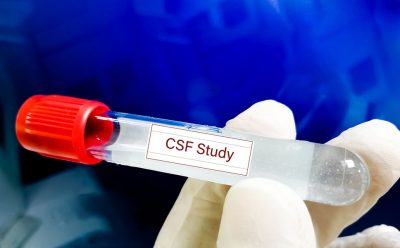
Absence of Pleocytosis in Cerebrospinal Fluid Does Not Rule Out Encephalitis
November 1, 2025
By Richard R. Watkins, MD, MS, FACP, FIDSA, FISAC
Synopsis: A retrospective study that included 597 adults with encephalitis found 25.3% did not have pleocytosis in their cerebrospinal fluid, and 23.7% of those with HSV-1 encephalitis lacked pleocytosis on the initial lumbar puncture.
Source: Habis R, Kolchinski A, Heck AN, et al. Absence of cerebrospinal fluid pleocytosis in encephalitis. Clin Infect Dis. 2025;81:179-187.
Encephalitis can be very challenging to diagnose in clinical practice, particularly in older adult patients and those with comorbidities. Rapid recognition and treatment are vital to achieving optimal outcomes. Clinical case definitions in guidelines and other clinical support tools use cerebrospinal fluid (CSF) pleocytosis (≥ 5 white blood cells/mm3) as a key factor to identify inflammation of the central nervous system (CNS) with encephalitis.1 Habis and colleagues sought to assess the outcomes linked to the presence or absence of pleocytosis in the initial CSF studies of patients with encephalitis and whether this affected the administration of antiviral therapy.
The study was a retrospective cohort analysis of patients aged 18 years and older with a discharge diagnosis of encephalitis from two hospitals in Texas and two in Maryland. Patients with meningitis were excluded, as were patients transferred from an outside institution without available data on their initial workup and CSF results. Delay in antiviral administration was recorded as the time in days from the first lumbar puncture (LP) to the start of acyclovir. Univariate analysis was performed to identify and characterize the clinical presentation, laboratory, and neurologic workup, and outcomes associated with normocellular CSF in patients with encephalitis compared to those with CSF pleocytosis.
The analysis included 597 patients, with 233 from Maryland and 364 from Texas. Of these, 446 (74.7%) had CSF pleocytosis and 151 (25.3%) did not. There were no differences in the presence of pleocytosis based on age, gender, or immune status. Patients with a fever were more likely to have pleocytosis (58.5%) than those without a fever (35.8%; P < 0.001) as well as a headache (51.6% with pleocytosis vs. 29.8% without; P < 0.001). Furthermore, new-onset seizures, psychiatric symptoms, and memory deficits were more common in patients without pleocytosis. Of those with pleocytosis, more had infectious encephalitis (200/446, 44.8%) than autoimmune encephalitis (59/446, 13.2%; P < 0.001 compared to no pleocytosis). They also were more likely to have peripheral leukocytosis (serum white blood cell [WBC] count > 11,000 cells/µL) than those without pleocytosis.
In the encephalitis cases with a viral etiology, 76 out of 190 (40%) tested positive by polymerase chain reaction (PCR) for herpes simplex virus 1 (HSV-1). Of these, 58 (76.3%) had pleocytosis and 18 (23.7%) did not. Those with pleocytosis and HSV-1 had a higher incidence of fever (46/58, 79.3%) and headache (38/58, 65.5%) compared to those without pleocytosis (fever in 8/18 [44.4%] and headache in 6/18 [33.3%]; P = 0.004 and P = 0.02, respectively). Of note, magnetic resonance imaging (MRI) abnormalities were more common in patients with pleocytosis (40/47, 87%) compared to those without (9/15, 60%; P = 0.02). It was not uncommon for those with HSV-1 encephalitis to have a normal MRI (12/61, 19.7%). Most patients with autoimmune encephalitis had pleocytosis (59/97, 60.8%). Furthermore, those with anti-N-methyl-D-aspartate receptor (anti-NMDA) encephalitis were more likely to have pleocytosis (37/59, 62.7%). Mortality was similar between patients with pleocytosis (40/433, 9%) and those without (16/151, 10.6%; P > 0.05).
Hospital length of stay did not vary based on the presence or absence of pleocytosis. There were no observed differences in the time from the initial LP to acyclovir initiation in those with pleocytosis. Finally, 71.1% of patients with pleocytosis received acyclovir while only 47.7% of those without pleocytosis received the drug (P < 0.001).
Commentary
This was a pragmatic study with important lessons for clinicians. Nearly one-quarter of patients with HSV-1 encephalitis did not have pleocytosis on their initial LP. There is robust evidence that timely initiation of acyclovir is crucial for optimal outcomes in HSV-1 encephalitis. Indeed, mortality from untreated HSV-1 encephalitis is > 70%, and delayed treatment often leads to chronic neurologic sequelae. The study by Habis et al highlights how relying on pleocytosis in the CSF alone to decide whether to start acyclovir is risky and ill-advised.
Other interesting findings were that almost 20% of HSV-1 cases had normal MRI findings, which rose to 40% in those without pleocytosis, and only 44% of those without pleocytosis had a fever. These results underscore the diagnostic conundrum that clinicians face when managing HSV-1 encephalitis. A high clinical suspicion is paramount even when classic textbook findings (e.g., fever and temporal lobe abnormality) are absent. Thus, a prudent diagnostic strategy should include HSV-1 polymerase chain reaction (PCR) testing of the CSF regardless of the WBC count and having a low threshold for repeating CSF studies when initial tests are negative.
In the study, the etiology of the encephalitis remained undiagnosed in 42% of the cases. This strongly implies that the current diagnostic paradigm is inadequate. Clinicians need to improve at elucidating infectious causes of encephalitis when pleocytosis is absent. Further research on the management of encephalitis in patients without pleocytosis is urgently needed.
Richard R. Watkins, MD, MS, FACP, FIDSA, FISAC, is Professor of Medicine, Division of Infectious Diseases, Northeast Ohio Medical University, Rootstown, OH.
Reference
1. Tunkel AR, Glaser CA, Bloch KC, et al. IDSA Guidelines for the Management of Encephalitis. Clin Infect Dis. 2008;47:303–327.